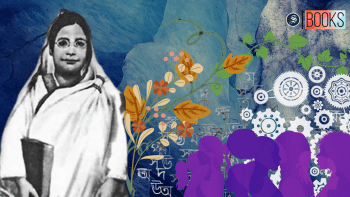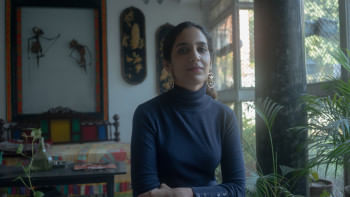Begum Rokeya and Begum Sufia An enduring “mother-daughter” bond

Begum Rokeya Sakhawat Hossain (1880-1932) and Begum Sufia Kamal (1911-1999), two icons in Bangla literature and culture, were not kins but kindred spirits. Their relationship grew from strength to strength through their interactions and shared commitments to humanitarian principles and practices, especially the emancipation of women, which can best be imagined and encapsulated in a mother-daughter trope.
Certain apparent parallels in their lives likely triggered this lasting relationship of mutual love and admiration. Both Rokeya and Sufia were born in aristocratic Muslim families and raised in a privileged but patriarchal and Urdu-speaking environment. Moreover, the duo were deprived of formal education in childhood and became victims of gender segregation and child marriage. Although prohibited from attending school, both became educators in adult life: Rokeya founded a school for Muslim girls in Calcutta in 1911, and Sufia taught at the Calcutta Corporation Free Primary School for Girls from 1933 to 1941.
Rokeya was married off as the second wife of an English-educated Deputy Magistrate, Syed Sakhawat Hossain, at the age of 16 (1896); Sufia was married to her cousin, Nehal Hossain, a student of law, at age 12 (1923). Thankfully, both their husbands were benevolent and liberal, opening the doors for their future success as writers and activists. They supported and even inspired their wives to write in Bangla, although Urdu was their family language—an exception that no doubt helped tilt the language preference of Bengali Muslim women from Urdu to Bangla.
Sufia first met Rokeya at her maternal aunt's home in Calcutta at age eight, where she had gone with her mother to visit her ailing elder brother. One day Rokeya casually dropped by the aunt's house as part of her routine visit to Muslim households in search of students. She struggled to find students for her school as Muslims were dogmatic and hostile to women's education. Therefore, when she saw little Sufia, she implored her mother to enroll the young girl at her school.
Sufia was hugely excited by this prospect and instantly expressed willingness to become Rokeya's student. However, Sufia's mother could not accept Rokeya's overture as they were visitors only and would soon have to return to their village home in Shyestabad, Barisal. Nevertheless, before their return, they toured the school, much to Sufia's excitement. Rokeya was a trailblazer in Muslim women's education; therefore, her presence must have cast a spell on the precocious Sufia, such that she could recall the details of this chance meeting with the luminary in her memoir, Ekale Amader Kaal, published about 70 years later (1988).
The second time Sufia met Rokeya was in 1928, when she moved to Calcutta with her husband. Though an adolescent, she probably still harboured the desire to study at Rokeya's school, as getting a formal education was Sufia's lifelong dream. But realising that it was impractical and wishful thinking, she decided to work as a volunteer in Rokeya's two organisations for the education and welfare of children and women: Anjuman-i-Khawtin-i-Islam, founded in 1916, and the Bengal chapter of All India Women's Conference, established in 1919.
These two organisations were groundbreaking initiatives by Rokeya to help the abused, oppressed and distressed women of all cultures and religions in British India—be they divorced and, therefore, unwarranted Catholic White women; indigent and illiterate Muslim women; women who had lost their caste in Hinduism for whatever frivolous reason; or the most ostracised, vilified and persecuted of all, the Untouchables (Dalits) in Hinduism. Sufia reminisces in her memoir how Rokeya would repeatedly advise her not to discriminate against any woman or child, whatever their background, and to treat everyone with equal respect and dignity as fellow human beings. This noble, humanitarian and philanthropic outlook of Rokeya made her the embodiment of all that Sufia aspired to be, so she began to regard her as a role model and mother figure.
Sufia was already a published writer and activist before becoming Rokeya's "intern" and "warrior" in her two altruistic networks. She published her first short story, "Sainik Bodhu," in 1923 and her first poem, "Basanti," in 1925. Her reform activities, some of them intuitively, began even earlier.
For example, although prohibited from school education, the "bad girl" maverick hoodwinked the family to challenge this patriarchal norm, albeit unknowingly, by attending school with her brother for some time disguised as a boy. She also continued to read Bangla magazines, including Tagore's Prabasi, in contravention of their family custom and the wishes of her elders. In 1925, she joined "Matri Mangal" as the first Muslim member of an organisation in Barisal run by Hindus and Brahmos for the welfare of women and children. She also met the nationalist leader Mahatma Gandhi the same year, disguised as a Hindu woman. Such activities suggest that, like Rokeya, Sufia was bold, dynamic, far-sighted and determined, even in childhood and adolescence, to change society by making it a level playing field.
Sufia worked with Rokeya for about four years until Rokeya's sudden death in 1932. The same year Sufia also lost her first husband to tuberculosis (she married Kamaluddin Ahmad in 1939). These two tragic incidents rattled her so profoundly that she confessed to writer Mahbubul Alam that she contemplated suicide.
However, during this short period of their association, Rokeya instilled the skills and values that Sufia cherished all her life. She taught her that as a feminist reformist, one must shun religious and cultural parochialism and be inclusive and cosmopolitan: help all abused and exploited women without prejudice.
She also taught her to be a practical idealist: be committed to the vision and mission but act so that they could attain their goal without riling the majority in society. On the subject of purdah, her advice was to be circumspect, as the extremists would exploit any potential irreverence. And as for the religious extremists, her recommendation was stoic indifference and silent persistence without rising to their bait. These are some of the strategies Sufia held in high regard and adopted in later life.
Rokeya's influence on Sufia's life and imagination was deep-seated, and she never downplayed it. Instead, she did everything to lionise Rokeya and project her true greatness as a writer and women's rights advocate. Sufia's reverence for Rokeya is evident in how she tried to nurture her memory in the hearts and minds of the Bengali people. For example, in 1946, Sufia initiated a kindergarten school with friends at Park Circus, Calcutta, calling it "Rokeya Memorial School." In 1949, she launched a new magazine as co-editor and titled it after the fictional character of Rokeya's "Sultana's Dream," the Weekly Sultana.
In 1950, she named her newly born daughter (now an Advocate and human rights activist) "Sultana," also after this fictional character. In 1960, she led a memorandum committee to name Dhaka University's first women's hostel "Rokeya Hall." In 1970, Sufia dedicated her eighth volume of poetry, Mrittikar Ghran, to Begum Rokeya. She also played a crucial role with the Bangladesh Mahila Parishad in establishing a Memorial for Rokeya in her native village of Pairabad, Rangpur.
She devoted almost one-third of her memoir to affirming her love and admiration for her mentor, who, by grooming her for four years, brought Sufia's blossoming talents to full bloom.
Mohammad A Quayum is a professor at the College of Humanities, Arts and Social Sciences, Flinders University, Adelaide.

 For all latest news, follow The Daily Star's Google News channel.
For all latest news, follow The Daily Star's Google News channel. 







Comments